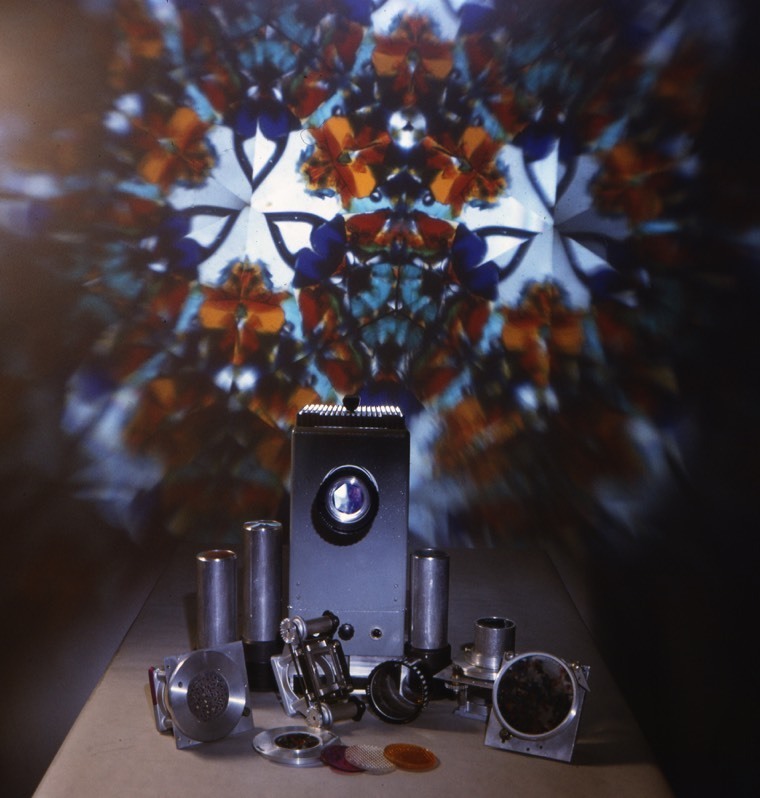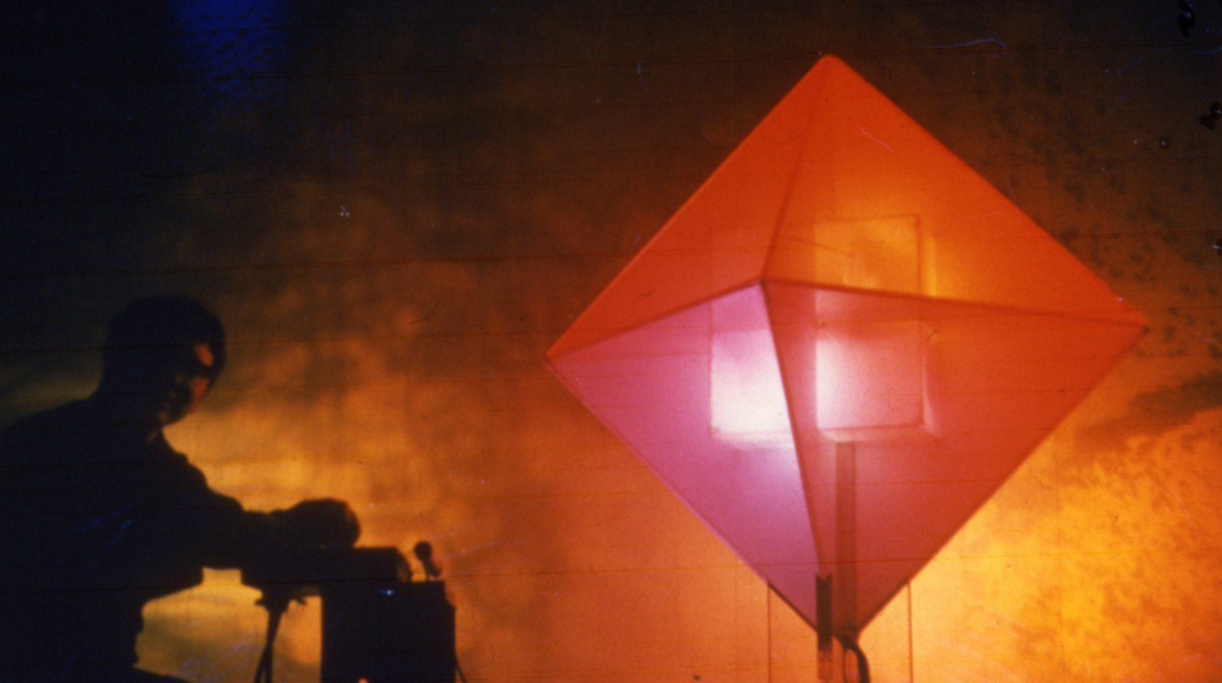Art form: laser media installation
Style: new media art
Method: laser projection, video mapping, generative art
Material: lasers
Location: Almetevsk city (Russia, Tatarstan Republic)
Style: new media art
Method: laser projection, video mapping, generative art
Material: lasers
Location: Almetevsk city (Russia, Tatarstan Republic)
SETUP are the followers of Bulat Galeev, a native of Kazan. He was a man who was one of the first in the world to experiment with light and music. Being a fan of Scriabin's ideas, he believed that light can be heard and sound can be seen.
Moscow-based crew installed a staged light projection on the walls of the local industrial heating station area. Seven lasers installed outside the station area project five scenes on the walls of the building, which are devoted to the topics of nature, energy, digital art, local visual code and the art studio heritage. Scenes change automatically and are played at night.
Significance of this artwork is encoded in its name. From Tatarian «nokta» means a dot, or a point. It is a word which derived from the Arabic language. In philosophy the term «point» stands for the intersection of the conceivable and the visible. It is the basement of the whole ground, it is the beginning and the end. Point on the world map is the place endowed with a special visual code and culture. A point in space and plane is an abstract object, lying in the ground of any geometric figure. Comprehending all the mentioned meanings of the word,
S E T U P studio artist Pavel Zmunchila explains: «A laser beam is almost the same point, which can move in space at a high speed. The result of its moving we recognize as a complex geometric pattern, which in fact can be seen on the installation». The laser projection made with a multitude of abstract points becomes a symbolic beginning of the artistic comprehension of the surrounding space: its visual culture and physical position.
Moreover, the laser installation is projected on the building of APTS №2, where another artwork is already placed, a mural «Theories of the Genesis of Oil» by Artem Stefanov. It brings an additional sense to the installation: oil turns into a symbolic point, from which the urban development of Almetyevsk has started.
One of the distinctive features of the artwork is the continuity of the projection covering the building walls. «We made lots of things for the first time. For example, we supplied such a huge area with lasers, then joined the projections», Pavel Zmunchila recalls. «The thing is that one laser simultaneously projects an image on the piece of wall, stacks and other objects, which have their own geometry. Almost no one takes on such a project. In Russia no one has done this before».
The whole series of projections lasts for 12 minutes. The first one outlines the contour of the APTS №2 building. The second one «cuts» the object, demonstrating the interior of the station. The artists used not only futuristic colours for installation but also common for these places patterns. For example, red and green are the colours of the national flag of Tatarstan. The third scene was done using generative art techniques, in other words it was created by a mathematical algorithm, which never repeats the same patterns of the image. This part of the artwork is completely controlled by the computer code, and it raises the question about the role of new technologies in the world. The fourth scene reflects a visual code of Almetyevsk: traditional Tatar floral patterns. The last scene is video mapping. During this performance three-dimensional projections are created and superimposed on the mural of Artem Stefanov, outlining the contours of the work.
Significance of this artwork is encoded in its name. From Tatarian «nokta» means a dot, or a point. It is a word which derived from the Arabic language. In philosophy the term «point» stands for the intersection of the conceivable and the visible. It is the basement of the whole ground, it is the beginning and the end. Point on the world map is the place endowed with a special visual code and culture. A point in space and plane is an abstract object, lying in the ground of any geometric figure. Comprehending all the mentioned meanings of the word,
S E T U P studio artist Pavel Zmunchila explains: «A laser beam is almost the same point, which can move in space at a high speed. The result of its moving we recognize as a complex geometric pattern, which in fact can be seen on the installation». The laser projection made with a multitude of abstract points becomes a symbolic beginning of the artistic comprehension of the surrounding space: its visual culture and physical position.
Moreover, the laser installation is projected on the building of APTS №2, where another artwork is already placed, a mural «Theories of the Genesis of Oil» by Artem Stefanov. It brings an additional sense to the installation: oil turns into a symbolic point, from which the urban development of Almetyevsk has started.
One of the distinctive features of the artwork is the continuity of the projection covering the building walls. «We made lots of things for the first time. For example, we supplied such a huge area with lasers, then joined the projections», Pavel Zmunchila recalls. «The thing is that one laser simultaneously projects an image on the piece of wall, stacks and other objects, which have their own geometry. Almost no one takes on such a project. In Russia no one has done this before».
The whole series of projections lasts for 12 minutes. The first one outlines the contour of the APTS №2 building. The second one «cuts» the object, demonstrating the interior of the station. The artists used not only futuristic colours for installation but also common for these places patterns. For example, red and green are the colours of the national flag of Tatarstan. The third scene was done using generative art techniques, in other words it was created by a mathematical algorithm, which never repeats the same patterns of the image. This part of the artwork is completely controlled by the computer code, and it raises the question about the role of new technologies in the world. The fourth scene reflects a visual code of Almetyevsk: traditional Tatar floral patterns. The last scene is video mapping. During this performance three-dimensional projections are created and superimposed on the mural of Artem Stefanov, outlining the contours of the work.

Context
Bulat Galeev and the Prometey Research Institute: Russia's first art experiments with light that influenced contemporary media art.
Bulat Galeev is a scientist and artist from Tatarstan, who stood at the origins of the Russian media art. He was a member of the Soviet experimental association called the Prometey Research Institute. His modern successors Moscow-based
S E T U P studio made a series of laser projections in Almetyevsk, which are devoted to research of laser projections, nature and visual code of the town.
In the early 60s «Laboratory 26a» was established on the base of the Kazan Aviation Institute. Later it was renamed into the Prometey Research Institute as a tribute to Alexander Scriabin's poem, the first writing ever with a lighting plot. «Prometey» founders were inspired by abstract ideas of Wassily Kandinskiy, which were formulated by Anatoly Lunacharsky: «The music of colour, symphony of patterns and linear melodies is quite conceivable, especially in fusion with the music of sounds».
The Prometey Research Institute invented music-light devices that react to sounds by changing their glow. They also created the USSR's first media installations, and scientists also conducted experiments in the field of light architecture. A graduate of the Faculty of Physics and Mathematics Bulat Galeev joined the team of the Research Institute from the first years of its existence and soon became the head of the laboratory.
Bulat Galeev (1940–2009) is a physician, engineer, constructor, pioneer of Russian media art and specialist in the synthesis theory of various types of arts.
Galeev kept a lively correspondence with Western artists and composers, adherents of scientific progress Nicolas Schöffer, Frank Malina, Yanis Ksenakis, Lev Termen and Stelarc. For half a century he created a number of great projects that have influenced contemporary media art. For instance, he made an installation called «The dogs bark, but the camels move on», where a computer drawn big camel walked slowly to the music «Bolero» by Maurice Ravel. Under the screen with the camel there was another screen with a synchronously barking dog.
Another cult work is the automated system «Man-machine»: there was a light-music performance on the screen, which appeared there only when the system worked normally. When the system failed, the performance was displaced. The installation called «Mellow Chime» illuminated the walls of the Kazan Kremlin's belfry in proportion to the volume of the bell.
Bulat Galeev and the Prometey Research Institute: Russia's first art experiments with light that influenced contemporary media art.
Bulat Galeev is a scientist and artist from Tatarstan, who stood at the origins of the Russian media art. He was a member of the Soviet experimental association called the Prometey Research Institute. His modern successors Moscow-based
S E T U P studio made a series of laser projections in Almetyevsk, which are devoted to research of laser projections, nature and visual code of the town.
In the early 60s «Laboratory 26a» was established on the base of the Kazan Aviation Institute. Later it was renamed into the Prometey Research Institute as a tribute to Alexander Scriabin's poem, the first writing ever with a lighting plot. «Prometey» founders were inspired by abstract ideas of Wassily Kandinskiy, which were formulated by Anatoly Lunacharsky: «The music of colour, symphony of patterns and linear melodies is quite conceivable, especially in fusion with the music of sounds».
The Prometey Research Institute invented music-light devices that react to sounds by changing their glow. They also created the USSR's first media installations, and scientists also conducted experiments in the field of light architecture. A graduate of the Faculty of Physics and Mathematics Bulat Galeev joined the team of the Research Institute from the first years of its existence and soon became the head of the laboratory.
Bulat Galeev (1940–2009) is a physician, engineer, constructor, pioneer of Russian media art and specialist in the synthesis theory of various types of arts.
Galeev kept a lively correspondence with Western artists and composers, adherents of scientific progress Nicolas Schöffer, Frank Malina, Yanis Ksenakis, Lev Termen and Stelarc. For half a century he created a number of great projects that have influenced contemporary media art. For instance, he made an installation called «The dogs bark, but the camels move on», where a computer drawn big camel walked slowly to the music «Bolero» by Maurice Ravel. Under the screen with the camel there was another screen with a synchronously barking dog.
Another cult work is the automated system «Man-machine»: there was a light-music performance on the screen, which appeared there only when the system worked normally. When the system failed, the performance was displaced. The installation called «Mellow Chime» illuminated the walls of the Kazan Kremlin's belfry in proportion to the volume of the bell.





NOKTA
laser media installation
laser media installation